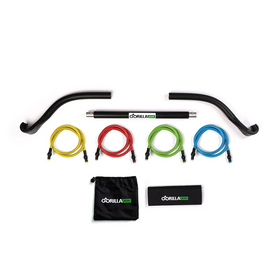Top 10 Benefits of Combining Cardio with Resistance Training

Are you torn between spending your workout time on cardio exercises or building muscle with resistance training? It's a common dilemma for many fitness enthusiasts. Fortunately, you don't have to choose one over the other. In fact, combining cardio with resistance training can provide a wide range of benefits that can help you achieve your fitness goals more effectively. Here, we'll explore the advantages of blending these two workout styles and why it's worth incorporating both into your fitness routine.
Understanding Cardio and Resistance Training
Before we dive into the benefits of combining cardio and resistance training, let's briefly understand what each of these exercises entails.
-
Cardiovascular (Cardio) Training:
- Cardio exercises involve activities that elevate your heart rate and increase your breathing rate.
- These workouts primarily target your cardiovascular system, improving your endurance, stamina, and overall heart health.
- Common forms of cardio include running, cycling, swimming, and jumping rope.
-
Resistance Training:
- Resistance training, also known as strength or weight training, focuses on building muscle strength and mass.
- It involves using resistance bands, lifting weights or using your body weight as resistance to challenge your muscles.
- Exercises like weightlifting, bodyweight exercises (e.g., push-ups and squats), and resistance bands fall into this category.
Now that we've clarified these two training styles let's explore the benefits of combining them.
The Benefits of Combining Cardio with Resistance Training
1. Efficient Fat Loss
If your goal is to shed unwanted body fat, combining cardio with resistance training is a powerful strategy. Cardio workouts help you burn calories during exercise, while resistance training helps build lean muscle mass. The more muscle you have, the more calories your body burns at rest. Therefore, when you incorporate both types of training, you create a dual-action effect for fat loss.
During a cardio session, you may burn a significant number of calories, but the calorie-burning process stops shortly after you finish exercising. On the other hand, resistance training contributes to the long-term calorie burn by increasing your basal metabolic rate (BMR). This means you'll continue burning calories even when you're not working out.
2. Improved Muscle Tone and Definition
While cardio helps you lose fat, resistance training is essential for sculpting and defining your muscles. Combining these two forms of exercise ensures that you not only shed excess fat but also reveal a toned physique beneath it.
Resistance training targets specific muscle groups, allowing you to shape and strengthen areas that may be weaker or less defined. For example, squats and lunges can help you sculpt your lower body, while bench presses and pull-ups can enhance your upper body definition.
3. Enhanced Metabolic Rate
Metabolism plays a crucial role in determining your body's ability to burn calories and maintain a healthy weight. When you engage in resistance training, you promote muscle growth. Muscles are metabolically active tissues, meaning they require energy (calories) to function and repair themselves. As a result, having more muscle mass boosts your metabolic rate.
Incorporating cardio into your routine can further enhance this effect. The post-workout "afterburn" (excess post-exercise oxygen consumption or EPOC) following a challenging cardio session can help elevate your metabolic rate for hours, aiding in calorie burning and weight management.
4. Cardiovascular Health
While resistance training primarily targets muscle development, it doesn't neglect your cardiovascular system. Many compound resistance exercises, such as deadlifts and kettlebell swings, elevate your heart rate and can be demanding on your cardiovascular system. This helps improve your cardiovascular fitness to some extent.
However, dedicated cardio workouts remain the best way to strengthen your heart and lungs. Combining cardio with resistance training ensures a well-rounded approach to fitness that benefits your heart health. A healthy heart is essential for overall well-being and can reduce the risk of heart-related diseases.
5. Better Functional Fitness
Functional fitness involves training your body for everyday activities, such as lifting groceries, climbing stairs, or playing sports. Combining cardio and resistance training helps you build strength, endurance, and flexibility, all of which are crucial for performing these everyday tasks with ease.
Cardio workouts improve your endurance and stamina, allowing you to sustain physical activities for longer periods. Resistance training enhances your strength, making it easier to handle various physical challenges in your daily life. The combination of these two training styles prepares your body for a wide range of real-world situations.
6. Enhanced Weight Management
Maintaining a healthy weight is a common fitness goal, and combining cardio with resistance training can be an effective strategy for achieving and sustaining it. As mentioned earlier, this approach helps you burn calories during workouts and boosts your metabolic rate, making it easier to manage your weight.
Moreover, resistance training can prevent muscle loss that often accompanies weight loss. When you lose weight, you risk losing both fat and muscle. However, resistance training helps preserve and even build muscle, ensuring that your weight loss primarily consists of fat.
7. Variety and Reduced Boredom
Monotony can be one of the biggest roadblocks to sticking with a fitness routine. Doing the same exercises day in and day out can become tedious, leading to boredom and a loss of motivation. Combining cardio with resistance training allows you to vary your workouts, making them more enjoyable and engaging.
You can switch between different forms of cardio (e.g., running, swimming, and cycling) and try various resistance training exercises (e.g., dumbbell workouts, bodyweight exercises, and resistance bands). This variety not only keeps things interesting but also challenges different muscle groups, preventing overuse injuries and promoting overall fitness.
8. Faster Progress and Plateau Avoidance
If you've been exclusively doing cardio or resistance training for an extended period, you may have noticed that your progress has plateaued. Your body adapts to the specific demands of a single type of exercise, and the benefits start to level off.
By combining cardio with resistance training, you continuously challenge your body in new ways. This can lead to faster progress in terms of strength gains, endurance improvements, and body composition changes. Breaking through plateaus becomes more manageable when you have a diverse workout routine.
9. Better Mental Health
Exercise is not only beneficial for your physical health but also for your mental well-being. Both cardio and resistance training release endorphins, which are natural mood lifters. Engaging in regular exercise can reduce stress, anxiety, and symptoms of depression.
Furthermore, the variety provided by combining cardio and resistance training can keep your workouts mentally stimulating. The satisfaction of achieving fitness goals and seeing physical improvements can boost your self-esteem and overall sense of well-being.
10. Versatility in Achieving Fitness Goals
The beauty of combining cardio with resistance training is that it caters to a wide range of fitness goals. Whether you want to lose weight, build muscle, increase endurance, or improve your overall health, this dual approach can be customized to meet your specific objectives.
For example, if you're primarily interested in muscle building, you can focus more on resistance training while still incorporating some cardio for cardiovascular health. Conversely, if your goal is to improve your running performance, you can prioritize cardio workouts while adding resistance training to prevent muscle imbalances.
Incorporating both cardio and resistance training into your fitness routine offers a myriad of benefits that can help you achieve a well-rounded, healthy, and balanced physique. Whether you're aiming for weight loss, muscle gain, or overall fitness improvement, this combination provides a versatile approach to meet your goals.
Remember that the key to success lies in finding the right balance between cardio and resistance training that aligns with your fitness objectives and preferences. Consult with a fitness professional or personal trainer if you're unsure about the best approach for your specific needs.
So, why choose one when you can have the best of both worlds? Combining cardio with resistance training offers a holistic fitness solution that enhances not only your physical health but also your mental well-being. Embrace this balanced approach, stay consistent, and watch your fitness goals become a reality.










Leave a comment